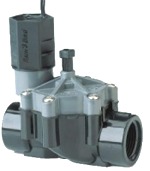Sprinkler valve
Contents
General Information
Sprinkler valves are the most commonly used valve on pneumatic launchers, and offer a number of desirable qualities. Because they are intended for use with home watering systems, sprinkler valves are readily available at nearly any location that sells PVC pipe and fittings. Sprinkler valves are intended for electronic actuation, however most are modified for pneumatic actuation, offering better performance in spudding applications.
Unfortunately for spudders sprinkler valves are not designed to open quickly since the speed of the valve has little affect on their intended use in sprinkler systems. In addition the large number of internal turns decreases the flow by roughly 25% compared to a piston valve of the same seat diameter, though muzzle velocity only decreases by about 10%.
Valve Actuation
A sprinkler valve can be actuated, or opened, in a number of ways. Though they are intended to be opened by the application of 24VAC to the solenoid, many opt for a modification allowing the pilot to be vented through another valve. Typically a Blowgun is used, though ball valves and even other sprinkler valves can do the job.
Electronic Actuation
Though electronically actuated valves open slower and offer poorer performance over their pneumatically modified counterparts, many spudders prefer this method, since it does not require altering the valve in any way.
Although most sprinkler valves are intended to operate on 24VAC, they can be successfully opened with 9-27VDC, usually applied by one, two, or three 9v batteries. The power source is wired in series with the solenoid and a switch. The solenoid will retract and the valve will open when voltage is applied.
Stock sprinkler valves can be fired remotely using a simple electronic circuit. Check out the remotely activated valve tutorial for more information.
Pneumatic Actuation
The performance of a valve can be improved by replacing the stock solenoid-valve vent with a pilot valve with more flow. Most often this is a blow gun, although for larger valves a ball valve or even a smaller sprinkler valve can be used. This operation is often called modding the valve.
Advanced Pneumatic Actuation
The stock diaphragm can also be replaced for a lighter, higher flow, homemade one, or even a piston for maximum power
Troubleshooting
If you are having problems with your sprinkler valve, these are some things to try
Valve "Honks" or "sounds like an airhorn"
You need a larger pilot valve. For more information, see honking.
Valve won't seal
If your valve leaks air out the barrel there is a good chance that there is dirt, PVC shavings etc. in the valve preventing it from closing properly. An easy way to clean the valve it to just hook it up to a hose and flush water through it while cycling the valve a few times. If that doesn't fix the problem then you should disassemble the valve and clean the diaphragm and seat. Check for any plastic chips that may have entered the valve. Smear the diaphragm and seat with lithium grease to promote a seal.
For other problems, visit the Sprinkler Valve Troubleshooting Guide [1]
More Information
GGDT's website has valve data for sprinklers in it's design library
The Sprinkler Valve is a comprehensive e-book written to answer the most common questions, and the not-so-common questions, that may arise from using this valve. It also shows, in detail, the basic modification process, as well as a few advanced modifications.
